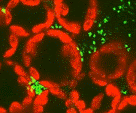Plant Pathology Department
Document Type
Article
Date of this Version
2016
Citation
Funnell-Harris, D. L., O’Neill, P. M., Sattler, S. E. and Yerka, M. K. Response of sweet sorghum 7 lines to stalk pathogens Fusarium thapsinum and Macrophomina phaseolina.
Abstract
Sweet sorghum [Sorghum bicolor (L.) Moench] has potential for bioenergy. Itis adapted to a variety of U.S. locations and the extracted juice can be directly fermented into ethanol. However, little research on fungal stalk rots, diseases that pose serious constraints for yield and quality of juice and biomass, has been reported. A greenhouse bioassay was designed to assess charcoal rot (Macrophomina phaseolina) and Fusarium stalk rot (Fusarium thapsinum) in plants at maturity, the developmental stage at which these diseases are manifested. Multiple plantings of a susceptible grain line, RTx430, were used as a control for variation in flowering times amongst sweet sorghum lines. Lesion length measurements in inoculated peduncles were used to quantify disease severity. Sweet sorghum lines ‘Rio’ and M81E exhibited resistance to F. thapsinum and M. phaseolina, respectively, and in contrast, line ‘Colman’ exhibited susceptibility to both pathogens. Lesion development over time in Colman was monitored. These results will enhance molecular and biochemical analyses of responses to pathogens, and breeding stalk rot resistant sweet sorghum lines.


Comments
U.S. government work.